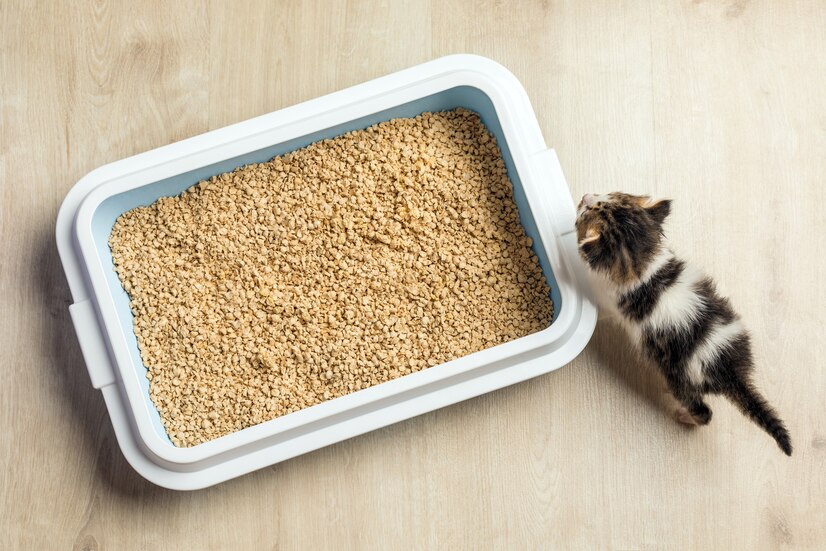Have you noticed your cat peeing outside the litter box? If you’re facing this problem, you’re not alone. There are a lot of reasons why cats might start to pee everywhere, leaving you to clean up urine with a bad smell.
If two days have passed and your cat is still doing this, your first and urgent step should be to visit your vet. Cats are clean creatures and love cleanliness, so don’t punish your cat if it’s peeing outside the litter box—it’s not their fault. There could be many reasons, including medical conditions, stress, litter box issues, and behavioral problems.
Read
Why Is My Cat Pooping Outside the Litter Box?
Don’t yell at your cat, as this could cause them to feel stressed or depressed. Instead, you should visit your vet or a cat behaviorist specialist. The vet will conduct urine and blood tests to diagnose any medical issues, while the behaviorist will help you manage their behavior if there is no medical problem.
Here, we will discuss all the possible reasons and facts behind why your cat is peeing outside the litter box, especially on beds and sofas. Furthermore, we will explore how to stop your cat from peeing everywhere and how to encourage them to use the litter box.
Why Is My Cat Peeing Outside the Litter Box?
Medical Reasons
You should inform your vet how many days it has been since your cat started urinating outside the litter box, and if possible, how many times a day your cat is peeing. Your vet will likely perform two tests:
- Urine test
- Blood test
These tests will help identify any possible medical reasons behind the issue. Some medical problems that could be causing this behavior include:
Urinary Tract Infection (UTI)
How can you tell at home if your cat has a urinary tract infection? You may notice blood in the urine, frequent urination, your cat crying in pain, and possibly passing only small amounts of urine throughout the day. This infection is more commonly found in older cats than in younger ones.
When bacteria enter your cat’s bladder through the urethra, the urine in the bladder becomes less sterile, allowing bacteria to grow, which can lead to a UTI.
Bladder Stones
Bladder stones in cats often form when they are fed only dry food and have no access to fresh water. Certain cat breeds, such as Persian or Himalayan, are more prone to bladder stones, and the age of the cat can also be a factor. A cat with bladder stones may also develop a urinary tract infection. These stones can cause blockages and irritation, leading to frequent urination.
Read
How Many Litter Boxes Per Cat?
An X-ray is the best way to diagnose how large the stones are in the bladder. This helps the vet to treat the issue properly. Ultimately, it is essential to maintain a balanced diet for your cat, following your vet’s recommendations.
Crystals in the Urine
If your cat is licking their genitalia frequently, has blood in their urine, and is straining to urinate, there might be crystals in their urine. Your vet will likely perform a well-known test called a “urinalysis” to confirm the presence of crystals in your cat’s urine.
This issue can occur when your cat isn’t drinking enough water and has abnormal urine pH levels. Crystals in a cat’s urine can also lead to bladder stones and urinary tract infections.
To prevent this, you should ensure your cat has adequate water intake. If your cat is not drinking enough water, you can offer wet food or certain vegetables high in water content, like carrots, but only after discussing this with your vet.
Degenerative Joint Disease
If your cat’s litter box is in a location that’s hard to reach, such as a toilet, and your cat has degenerative joint disease (a common issue in older cats), it might be difficult for them to use the litter box. As a result, they may start urinating on the sofa, carpet, or bed where they are resting.
Read
How Often Should You Change Cat Litter?
Check if your cat is walking properly. If they are not walking normally, it could indicate joint pain. Treating joint pain in cats requires appropriate treatment based on the cat’s breed and age, so it’s best to consult with your vet for a suitable plan.
Kidney Disease
Kidney disease is common in cats, regardless of their age. Some signs that might indicate kidney disease include:
- Increased thirst
- Frequent urination
- Vomiting
- Weight loss
To diagnose kidney disease, your vet may perform several tests, such as:
- Urinalysis
- Renal biopsy
- Blood urea nitrogen (BUN) test
- Renal ultrasonography
- Blood test
- Creatinine test
These tests will help ensure the proper treatment for your cat.
Read
Stages Of Kidney Disease In Cat
Other medical reasons include
- Diabetes
- Feline Idiopathic Cystitis
- Feline lower urinary tract disease
- Hyperthyroidism
Key Takeaways
- If your cat is medically cleared, there might be behavioral reasons behind this behavior.
- Work with a cat behaviorist without punishing your cat.
- Try to spend quality time with your cat and provide more than one litter box.
Behavioral Reasons
The Litter Box Isn’t Clean
Feline friends have a great sense of smell—14 times sharper than humans—and they prefer clean things, including their litter box. The litter box is the spot where cats do their business, and it must be kept clean each time. If your cat’s litter box is not clean, they won’t use it.
Have you ever noticed why your cat buries their waste after pooping or urinating in the litter box? Tell us in the comments why you think cats do this, based on your experience as a cat owner. My guess is it’s simply because they want a clean litter box.
Read
Can Cats Use the Same Litter Box?
Try to scoop their litter box daily. A clean litter box means they are less likely to do their business on beds, sofas, or carpets.
The Litter Box Is Hard to Reach
Most of the time, litter box use issues are a major concern for older cats. Their joint pain and vision problems can make them less energetic, and they may even feel pain when walking. If your cat’s litter box is in an area that’s hard to reach, they might stop using it.
So, what are the best places to put a cat litter box, and what should you avoid?
Best Places to Put a Cat Litter Box
- Quiet corners
- Bathrooms
- Laundry rooms
- Basements
- Closets with cat doors
Places to Avoid for a Cat Litter Box
- Near food and water bowls
- High-traffic areas
- Noisy appliances
- Dark and inaccessible corners
- Bedrooms
Your Cat Doesn’t Like Their Litter
Every cat is unique with individual behaviors and preferences, and this extends to their litter choices as well. Just because one cat likes a certain type of litter, like Fresco, doesn’t mean another cat will. Some cats might start peeing just outside the litter box if they don’t like the litter.
So, how do you select the best litter for your cat, and which type is best? The answer isn’t straightforward. You may need to test different litters to see which one your cat prefers and will use consistently.
A good litter is
- Absorbent
- Good at controlling odor
- Capable of clumping well
- Dust-free
- Non-toxic
- Low tracking
- Eco-friendly (optional
There Isn’t Enough Litter in the Box
Yes, you read that correctly—if there isn’t enough litter in the box, your cat might stop using it. Cats are very sensitive to odors and prefer privacy. They don’t want others to see their waste and will try to bury it. To do this, they rely on the litter to cover their business. If there isn’t enough litter for them to bury their waste properly, they may avoid using the box altogether, according to Jackson.
Older Urine Smells
Cats are attracted to their own scent, even if it’s the smell of their urine or poop. When your cat urinates somewhere outside the litter box, the scent of their urine can attract them to repeat the behavior in the same spot. To stop this, you can use:
- Cat pee, odor, and stain removal products
- Pet urine detectors
By using these products, you can effectively remove the lingering odors and discourage your cat from returning to the same spot.
There Aren’t Enough Litter Boxes
Peeing Outside the Litter Box can sometimes be due to having multiple cats in your home without enough litter boxes to accommodate them. The general rule is to have one more litter box than the number of cats. For example, if you have two cats, you should have three litter boxes. If you have three cats, you should have four litter boxes. This ensures each cat has its own box, plus an extra one for busy days or to prevent conflicts over litter box use.
It’s important to place each litter box in separate, low-traffic areas to give your cats privacy and avoid stress. Avoid high-traffic areas like the kitchen or near the main door.
Note: Covered litter boxes are not recommended, as some cats may feel confined and unable to see their surroundings, which can make them uncomfortable.
Your Cat Is Stressed or Anxious
Does your cat follow you to the bathroom or kitchen? If so, this might be a sign that they are stressed and seeking your attention, as they see you as their caretaker. The same principle applies if your cat stops using the litter box and starts peeing just in front of it—this behavior could indicate stress or anxiety. There are several reasons why your cat might be feeling stressed or anxious, including:
- Negative experiences with other pets or cats
- Dental issues
- Lack of a comfortable sleeping area
- Being stuck on the same diet
- Moving to a new place or home
- Not getting enough playtime or interaction
To reduce their anxiety and depression, provide your cat with toys and gadgets that interest them and spend quality time together to keep them happy and relaxed.
How to Stop Cat Peeing Problems and When to See a Vet
To stop a cat from peeing outside the litter box, first rule out medical concerns by consulting your vet. Improve litter box conditions by keeping them clean, accessible, and placing them in quiet areas away from food and water.
Use unscented, scoopable litter and ensure there are enough litter boxes—one per cat plus one extra. Reduce stress in your cat’s environment by providing toys, scratching posts, and vertical spaces. If problems persist, seek help from a professional behaviorist for further assistance.
Cat Peeing Outside the Litter Box FAQs
Should I punish my cat for peeing outside the litter box?
No, you should never punish your cat for peeing outside the litter box, because it’s not their fault. They might be dealing with medical or behavioral issues that prevent them from using the litter box.
One important step is to visit your vet to find out the underlying issue and get the appropriate treatment or advice.
Why is my cat peeing over the edge of the litter box?
There can also be medical and behavioral issues affecting your cat’s litter box habits. If the litter in the box is not clean enough or not to your cat’s liking, they might urinate on the edges of the box instead.
Additionally, cats with bladder stones or kidney disease may have trouble controlling their bladder and might end up peeing on the edges. If the litter box is clean, has enough litter, and your cat is still doing this, don’t wait—consult with your vet.
Read



